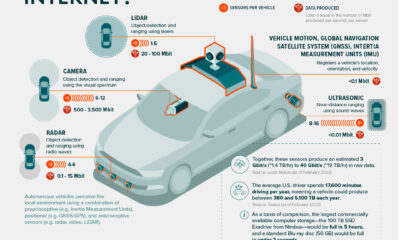Given the rising demand, what types of electric car models are available for U.S. consumers to choose from today? This graphic, using data from Car and Driver and EPA, highlights every single EV that’s available for sale across America, showing the wide range of manufacturers, vehicle types, and prices.
What Electric Vehicles Are Available in America?
As of February 2022, there are 28 different electric vehicles available in the U.S., from 18 different manufacturers. Here are their base model statistics: As of February 2022. *Indicates EPA data on fuel economy and range was only available for 2021 models. At less than $30,000, the Nissan Leaf and Mini Cooper SE are currently the most affordable options for Americans. Released in 2010, the Nissan Leaf is one of the oldest EVs on the market. Widely considered a pioneer in the EV space, it’s one of the top-selling electric cars in the U.S.—in 2021, more than 14,000 cars were sold in America. While the Leaf’s low price point may be appealing to many, it has the third shortest maximum range on the list at 149 miles before needing a recharge. The only other cars with shorter ranges were the Mini Cooper SE and the Mazda MX-30. GMC’s Hummer EV pickup is the most expensive EV on the list, with a base price point of $110,295—however, GMC is planning to release less expensive versions of the Hummer EV over the coming years. The only other EV pickup available in the U.S. market in early 2022 is Rivian’s R1T. However, more manufacturers like Ford and Chevrolet are planning to release their own EV pickups, and Tesla’s Cybertruck has been in the works for years. And new EVs are quickly entering the market. For example, BMW’s all-electric i4 and iX have only recently become available for sale in the U.S.
The Top EV Manufacturers
There are a number of domestic and international manufacturers that sell EVs in America, including German manufacturer Audi, Swedish carmaker Volvo, and South Korean manufacturer Kia. Here’s a breakdown of the 18 different manufacturers on the list, six of which are U.S. based: Tesla has the highest number of EV models on the market, with four different vehicles available: the Model S, Model X, Model Y, and the Model 3. It’s one of the few manufacturers on the list that exclusively makes electric cars—the only others being Rivian and Lucid. While anticipation has been building around Tesla’s Cybertruck, and murmurs of a cheaper Tesla have been circulating, Tesla’ CEO Elon Musk has confirmed that there will be no new Tesla models released in 2022. The company will instead focus on its existing models for the time being.
Are U.S. Consumers Ready to Transition to Electric Cars?
It’s important to note that, while EV adoption in America has increased over the years, the U.S. is still lagging behind other countries. Between 2015 and 2020, America’s EV fleet grew at an annual rate of 28%, while China’s grew by 51%, and Europe increased by 41%. Why are so many Americans dragging their feet when it comes to electric cars? According to a survey by Pew Research Center, the cost is a big barrier, as well as concerns over their reliability compared to gas vehicles. But with gas prices at all-time highs, and as consumers grow increasingly concerned over the carbon costs of gas vehicles, switching to an electric car may soon be too hard to resist. on Over recent decades, farmers have been able to more than double their production of crops thanks to fertilizers and the vital nutrients they contain. When crops are harvested, the essential nutrients are taken away with them to the dining table, resulting in the depletion of these nutrients in the soil. To replenish these nutrients, fertilizers are needed, and the cycle continues. The above infographic by Brazil Potash shows the role that each macronutrient plays in growing healthy, high-yielding crops.
Food for Growth
Nitrogen, phosphorus, and potassium (NPK) are three primary macronutrients that are the building blocks of the global fertilizer industry. Each plays a key role in plant nutrition and promoting crop growth with higher yields. Let’s take a look at how each macronutrient affects plant growth. If crops lack NPK macronutrients, they become vulnerable to various stresses caused by weather conditions, pests, and diseases. Therefore, it is crucial to maintain a balance of all three macronutrients for the production of healthy, high-yielding crops.
The Importance of Fertilizers
Humans identified the importance of using fertilizers, such as manure, to nourish crops dating back to nearly 6,000 to 2,400 BC. As agriculture became more intensive and large-scale, farmers began to experiment with different types of fertilizers. Today advanced chemical fertilizers are used across the globe to enhance global crop production. There are a myriad of factors that affect soil type, and so the farmable land must have a healthy balance of all three macronutrients to support high-yielding, healthy crops. Consequently, arable land around the world varies in the amount and type of fertilizer it needs. Fertilizers play an integral role in strengthening food security, and a supply of locally available fertilizer is needed in supporting global food systems in an ever-growing world. Brazil is one of the largest exporters of agricultural goods in the world. However, the country is vulnerable as it relies on importing more than 95% of its potash to support crop growth. Brazil Potash is developing a new potash project in Brazil to ensure a stable domestic source of this nutrient-rich fertilizer critical for global food security. Click here to learn more about fertilizer and food production in Brazil.































